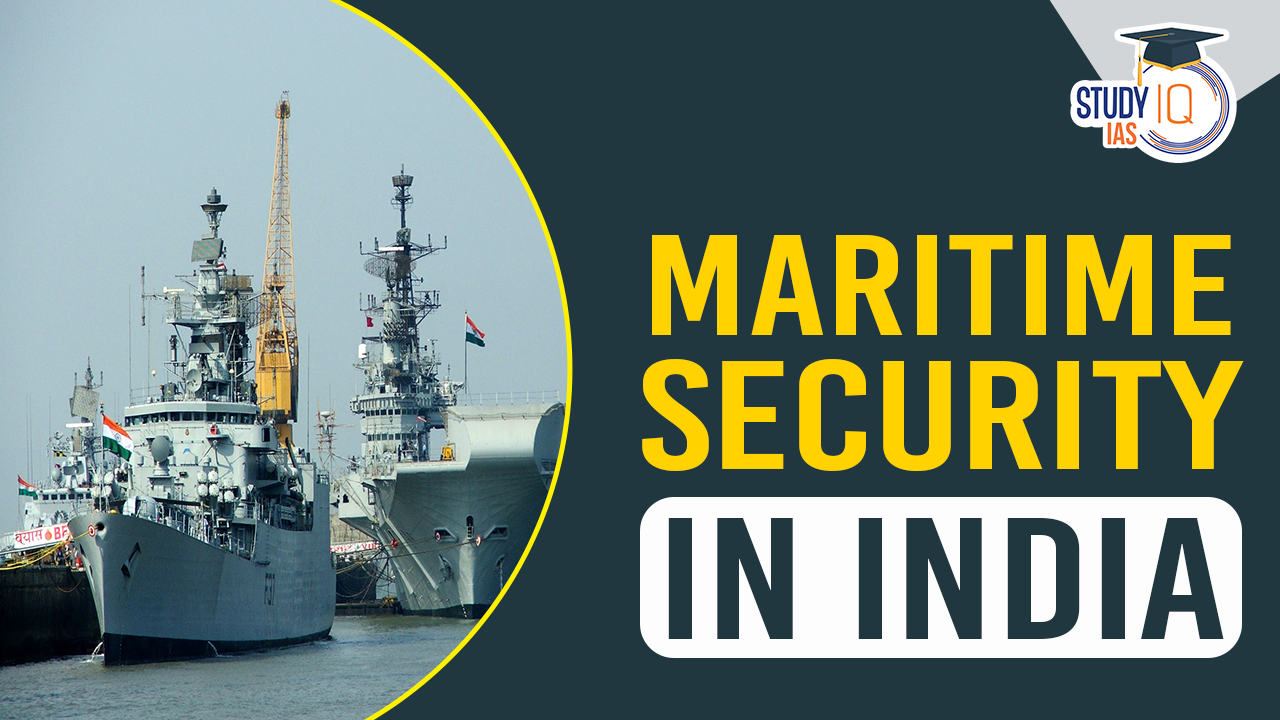Table of Contents
Context: Marine commandos (MARCOS) of the Indian Navy secured and safely evacuated all 21 crew members, including 15 Indians, from merchant vessel Lila Norfolk.
Maritime Security In India Introduction
- India is geographically located at the centre of the Indian Ocean, which serves as a vital conduit, connecting the East and West, and facilitating global trade and cultural exchange.
- India’s maritime territory comprises a lengthy coastline and a large exclusive economic zone (EEZ).
- India has an extensive coastline of 7517 km length, of which 5423 km is in peninsular India and 2094 km is in the 2 Andaman & Nicobar and Lakshadweep islands.
- India has the 18th-largest exclusive economic zone (EEZ) with a total size of 2,305,143 km2.
We’re now on WhatsApp. Click to Join
Significance of Maritime Security for India
- Maritime Economy: In terms of fish production, India ranks second in the world. The Indian Ocean has a vast deposit of polymetallic nodules, which is a valuable source of many minerals.
- Maritime Transportation: Over 70% of the value and nearly 95% of the volume of India’s international trade is transported by sea.
- Energy Resources: The Indian Ocean contributes around 40% of the world’s offshore oil production. Also, the region is a vital source of liquefied natural gas (LNG), and India, as the fourth-largest importer of LNG, depends significantly on these resources for its energy needs.
- Strategic Location: India’s geographical location at the centre of the Indian Ocean gives it a strategic advantage.
- Sea Lanes of Communication (SLOCs): The three major Sea Lanes of Communication (SLOCs) in the Indian Ocean are critical to global trade and energy security.
- Indian Diaspora: With many nations in the IOR, India has exchanged goods and maintained cultural ties. A key component of the maritime security framework is the safety and security of the Indian Diaspora living there.
Major Challenges for India’s Maritime Security
- Piracy: Somalia-based piracy remains a significant concern in the Indian Ocean region. Piracy activities can disrupt maritime trade, endanger seafarers, and pose a threat to India’s maritime interests.
- Trafficking: The Indian Ocean region is known for drug production centres like the Golden Triangle and Golden Crescent, as well as other destabilising activities such as gunrunning and human trafficking.
- Extra-Regional Military Presence: The growing presence of extra-regional powers, such as China, in the Indian Ocean raises concerns about the balance of power and potential security challenges.
- Maritime Terrorism: The extensive maritime activity in the IOR provides opportunities for terrorists to launch attacks on land, as demonstrated in the Mumbai terror attacks of 26/11.
- Regional Uncertainty: Political and security uncertainties in neighbouring countries like Somalia, Yemen, and Iran can lead to instability and insecurity in the IOR.
- Illegal Unreported and Unregulated (IUU) Fishing: IUU presents a threat to maritime security because it gives piracy a base of operations.
India’s Approach to Maritime Security
- Regional Cooperation: India actively engages with regional organisations and forums, such as the Indian Ocean Rim Association (IORA), to promote regional cooperation. India has also established initiatives like Security and Growth for All in the Region (SAGAR) and the Indo-Pacific Oceans Initiative (IPOI) to foster regional stability and security.
- Conflict Resolution through International Law: India emphasises the peaceful settlement of maritime disputes through international law and dialogue. India has been a party to the United Nations Convention on the Law of the Sea (UNCLOS), which lays down a comprehensive regime of law and order in the world’s oceans and seas establishing rules governing all uses of the oceans and their resources.
- Counterterrorism and HADR Operations: India has taken measures to enhance its capabilities in counterterrorism and Humanitarian Assistance and Disaster Relief (HADR) operations. For instance, India has emerged as a first responder during emergencies. E.g., Vaccine Maitri.
- Maritime Domain Awareness: India has increased its maritime presence beyond its Exclusive Economic Zone (EEZ) to enhance Maritime Domain Awareness (MDA) in the IOR. India has signed White Shipping agreements with multiple countries and established the Information Fusion Centre-Indian Ocean Region (IFC-IOR) to facilitate information sharing for comprehensive MDA.
- Promoting Sustainability: Under its ‘Blue Economy’ initiative it is promoting the utilisation of Maritime resources in sustainable ways.
- Project Mausam: It aims to re-connect and reestablish communications between countries of the Indian Ocean world.
- Infrastructure: Initiatives like Sagarmala have been launched to promote infrastructure in the region.
Present Maritime Security Mechanism
- Post-Mumbai attacks in 2008, an overhaul of the maritime security apparatus was witnessed with “emphasis on surveillance, intelligence gathering and information sharing amongst the various stakeholders”.
- Cabinet Committee on Security (CCS): In February 2009, the CCS vested the overall responsibility of maritime security with the Indian Navy (IN), including coastal security and offshore security.
- Currently, coastal security of India is governed by a three-tiered structure.
-
- The Indian Navy (IN) patrols the International Maritime Boundary Line (IMBL), while the Indian Coast Guard (ICG) is mandated to do patrolling and surveillance up to 200 nautical miles (i.e., EEZ).
- Simultaneously, the State Coastal/Marine Police (SC/MP) performs boat patrolling in shallow coastal areas.
- The SCP have jurisdiction up to 12 nautical miles from the coast; and the ICG and the IN have jurisdiction over the entire maritime zone (up to 200 nautical miles), including the territorial waters (with the SMP).
- The Border Security Force (BSF) is deployed in the creek areas of Gujarat and Sundarbans in West Bengal.
- Coastal Security Scheme: The Ministry of Home Affairs (MHA) has implemented a comprehensive Coastal Security Scheme to strengthen security infrastructure and capabilities of police of coastal states.
- NCSMCS: Coastal security is also reviewed periodically with all stakeholders by the National Committee for Strengthening Maritime and Coastal Security (NCSMCS), constituted under the Chairmanship of Cabinet Secretary.
Several Challenges in India’s Maritime Security Framework
- Resource Constraints: Limited resources, including naval vessels, aircraft, and surveillance equipment, can make it challenging to cover and secure such a vast maritime area adequately.
- Lack of Infrastructure: Insufficient coastal infrastructure, such as surveillance radars, coastal radar chains, and naval bases, hampers effective maritime surveillance and response.
- Overlapping Jurisdictions: Multiple agencies, including the Indian Navy, Indian Coast Guard, and State Coastal Police, share responsibilities, leading to potential jurisdictional overlaps and coordination issues.
- Technological Gaps: The need for advanced surveillance technology, including satellite-based monitoring, Automatic Identification System (AIS), and coastal radars, to detect and track vessels is essential but costly.
Way Forward
- 5-Point Framework on Maritime Security: The 5-point framework on maritime security by the UNSC should be implemented in letter and spirit. This includes:
-
- Free maritime trade without barriers to establishing legitimate trade.
- Settlement of maritime disputes should be peaceful and based on international law only.
- Responsible maritime connectivity should be encouraged.
- Need to collectively combat maritime threats posed by non-state actors and natural calamities.
- Preserve the maritime environment and maritime resources.
- Maritime Security Body: Efforts should be made to build consensus on the creation of a maritime security body in the UN Security Council, as proposed by the Russian President.
- Technological Advancement: Importing and implementing the most modern technology for predicting and preventing enemy attacks in oceans. Also, there is a need for modernization of the Navy.
- Policy Making: Maritime security should be an integral part of Indian Foreign Policy; a well-defined policy should be there.


 Monasteries in India: List of Major and ...
Monasteries in India: List of Major and ...
 National Doctor’s Day 2025: History, T...
National Doctor’s Day 2025: History, T...
 Bonalu Festival 2025: Date, History, Rit...
Bonalu Festival 2025: Date, History, Rit...





















